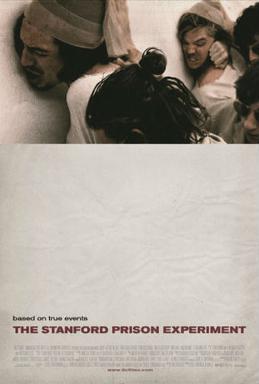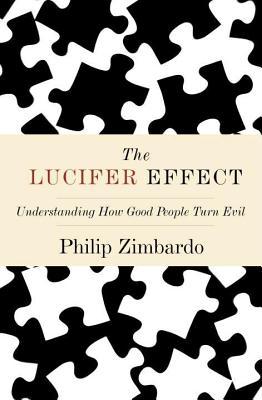
The Stanford prison experiment (SPE) was a psychological experiment conducted in the summer of 1971. It was a two-week simulation of a prison environment that examined the effects of situational variables on participants' reactions and behaviors. Stanford University psychology professor Philip Zimbardo led the research team who administered the study.
Obedience, in human behavior, is a form of "social influence in which a person yields to explicit instructions or orders from an authority figure". Obedience is generally distinguished from compliance, which is behavior influenced by peers, and from conformity, which is behavior intended to match that of the majority. Depending on context, obedience can be seen as moral, immoral, or amoral.

Philip George Zimbardo is an American psychologist and a professor emeritus at Stanford University. He became known for his 1971 Stanford prison experiment, which was later severely criticized for both ethical and scientific reasons. He has authored various introductory psychology textbooks for college students, and other notable works, including The Lucifer Effect, The Time Paradox, and The Time Cure. He is also the founder and president of the Heroic Imagination Project.
Ergophobia is an abnormal and persistent fear of work or fear of finding or losing employment. It is considered a form of social phobia or performance anxiety, as well as being recognised as a derivative of occupational burnout, derived from a persisting sense of pressure or excessive expectations in a workplace.
Deindividuation is a concept in social psychology that is generally thought of as the loss of self-awareness in groups, although this is a matter of contention. For the social psychologist, the level of analysis is the individual in the context of a social situation. As such, social psychologists emphasize the role of internal psychological processes. Other social scientists, such as sociologists, are more concerned with broad social, economic, political, and historical factors that influence events in a given society.
The two-factor theory of emotion states that emotion is based on two factors: physiological arousal and cognitive label. The theory was created by researchers Stanley Schachter and Jerome E. Singer. According to the theory, when an emotion is felt, a physiological arousal occurs and the person uses the immediate environment to search for emotional cues to label the physiological arousal. This can sometimes cause misinterpretations of emotions based on the body's physiological state. When the brain does not know why it feels an emotion it relies on external stimulation for cues on how to label the emotion.

Abbas Malekzadeh Milani is an Iranian-American historian, educator, and author. Milani is a visiting professor of political science, and the Hamid and Christina Moghadam Director of the Iranian Studies program at Stanford University. He is also a research fellow and co-director of the Iran Democracy Project at Stanford University's Hoover Institution. In Milani's book, Lost Wisdom: Rethinking Modernity in Iran, he has found evidence that Persian modernism dates back to more than 1,000 years ago.

The Experiment is a 2002 BBC documentary series in which 15 men are randomly selected to be either "prisoner" or guard, contained in a simulated prison over an eight-day period. Produced by Steve Reicher and Alex Haslam, it presents the findings of what has subsequently become known as the BBC Prison Study. These findings centered around "the social and psychological consequences of putting people in groups of unequal power" and "when people accept inequality and when they challenge it".

Emotional exhaustion is symptom of burnout, a chronic state of physical and emotional depletion that results from excessive work or personal demands, or continuous stress. It describes a feeling of being emotionally overextended and exhausted by one's work. It is manifested by both physical fatigue and a sense of feeling psychologically and emotionally "drained".
Work engagement is the "harnessing of organization member's selves to their work roles: in engagement, people employ and express themselves physically, cognitively, emotionally and mentally during role performances". Three aspects of work motivation are cognitive, emotional and physical engagement.

According to the World Health Organization (WHO), occupational burnout is a phenomenon resulting from chronic work-related stress, with symptoms characterized by "feelings of energy depletion or exhaustion; increased mental distance from one’s job, or feelings of negativism or cynicism related to one's job; and reduced professional efficacy". While occupational burnout may influence health and can be a reason for people contacting health services, it is not itself classified by the WHO as a medical condition or mental disorder. WHO additionally states that "Burn-out refers specifically to phenomena in the occupational context and should not be applied to describe experiences in other areas of life."
The Maslach Burnout Inventory(MBI) is a psychological assessment instrument comprising 22 symptom items pertaining to occupational burnout. The original form of the MBI was developed by Christina Maslach and Susan E. Jackson with the goal of assessing an individual's experience of burnout. As underlined by Schaufeli (2003), a major figure of burnout research, "the MBI is neither grounded in firm clinical observation nor based on sound theorising. Instead, it has been developed inductively by factor-analysing a rather arbitrary set of items" (p. 3). The instrument takes 10 minutes to complete. The MBI measures three dimensions of burnout: emotional exhaustion, depersonalization, and personal accomplishment.
Angeline Myra Keen (1905–1986) was an American malacologist and invertebrate paleontologist. She was an expert on the evolution of marine mollusks. With a PhD in psychology. Keen went from being a volunteer, identifying shells at Stanford, and having no formal training in biology or geology, to being one of the world's foremost malacologists. She was called the "First Lady of Malacology".

The Stanford Prison Experiment is a 2015 American docudrama thriller film directed by Kyle Patrick Alvarez, written by Tim Talbott, and starring Billy Crudup, Michael Angarano, Ezra Miller, Tye Sheridan, Keir Gilchrist, Olivia Thirlby, and Nelsan Ellis. The plot concerns the 1971 Stanford prison experiment, conducted at Stanford University under the supervision of psychology professor Philip Zimbardo, in which students played the role of either a prisoner or correctional officer.

Craig Haney is an American social psychologist and a professor at the University of California, Santa Cruz, noted for his work on the study of capital punishment and the psychological impact of imprisonment and prison isolation since the 1970s. He was a researcher on The Stanford Prison Experiment.
Jeanne Lavonne Humphrey Block was an American psychologist and expert on child development. She conducted research into sex-role socialization and, with her husband Jack Block, created a person-centered personality framework. Block was a fellow of the American Association for the Advancement of Science and conducted her research with the National Institute of Mental Health and the University of California, Berkeley. She was an active researcher when she was diagnosed with cancer in 1981.
Juliet Popper Shaffer is an American psychologist, statistician and statistics educator known for her research on multiple hypothesis testing. She is a teaching professor emerita at the University of California, Berkeley.

The Lucifer Effect: Understanding How Good People Turn Evil is a 2007 book which includes professor Philip Zimbardo's first detailed, written account of the events surrounding the 1971 Stanford Prison Experiment (SPE) – a prison simulation study which had to be discontinued after only six days due to several distressing outcomes and mental breaks of the participants. The book includes over 30 years of subsequent research into the psychological and social factors which result in immoral acts being committed by otherwise moral people. It also examines the prisoner abuse at Abu Ghraib in 2003, which has similarities to the Stanford experiment. The title takes its name from the pious story of the favored angel of God, Lucifer, his fall from grace, and his assumption of the role of Satan, the embodiment of evil. The book was briefly on The New York Times Non-Fiction Best Seller and won the American Psychological Association's 2008 William James Book Award.

Confined environment psychology is a refined subcategory of environmental psychology. There can be severe neurological impacts upon remaining in a confined environment over a prolonged period of time. Confined environment psychology can come in different forms, including; by location and lack of or limited human interaction. The broad subcategory also includes the effects of social isolation on animals.
Susan E. Jackson is an American researcher in the fields of managing for environmental sustainability, strategic human resource management, occupational burnout, and work team diversity. She was the co-author of the Maslach Burnout Inventory in 1981, the primary diagnostic instrument for the condition of occupational burnout.










